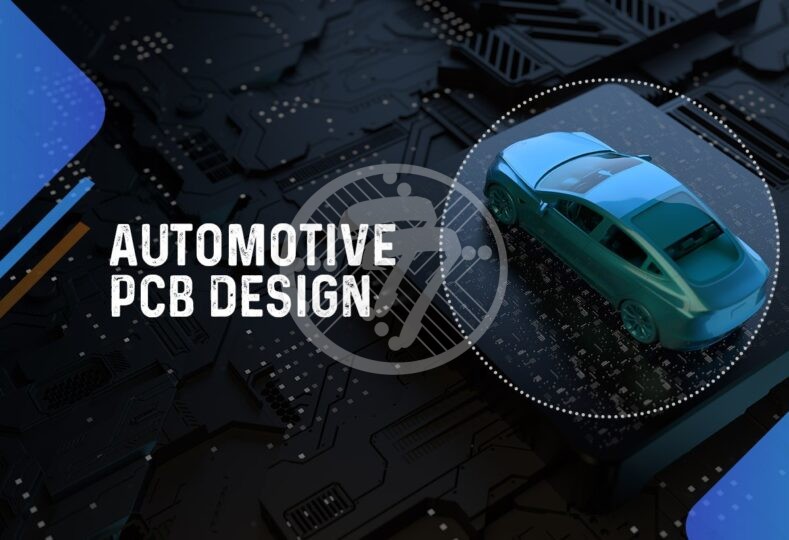A comprehensive guide to improve automotive PCB design!

Printed Circuit Boards are an integral part of almost every automobile. In fact the use of sophisticated PCBs has led to the incorporation of revolutionary features in automobiles including but not limited to keyless start, automated parking, autopilot & more.
The board design & layout has a crucial part to play when it comes to improved performance. Here are some deign guidelines to follow that can go a long way in improving efficiency.
Automotive PCB Design Guidelines:
1. Component Placement
Both the placement as well as orientation of components have a big role to play when it comes to the performance of the board. Some thumb rules to follow, include:
- Ensuring that similar components are placed in the same direction.
- If you are undertaking wave soldering, the components should be parallel to the direction of the wave.
- Ensure that inductors come with spaces in between.
- Inductors should be kept at right angles to each other to prevent crosstalk.
- The analog & digital components must be separated.
- Ensure that tall & short components aren’t placed adjacent to each other.
- High power components should be placed away from other components in order to ensure proper dissipation of heat.
2. Proper placement of leads
- Leads should not be placed too close to each other.
- Ensure proper grounding under the leads.
3. Signal Routing
For layers that conduct high current, the use of 2-4 vias is prudent. To ensure proper signal routing, the following principles come in handy:
- Power and ground planes must be placed on inner layers.
- Sensitive signals must be protected from noise sources.
- Use of shortest tracks is advisable.
- In routing the traces, the direction should be horizontal on one side and vertical on the other.
- In fact, the vertical & horizontal layers must be placed alternately.
4. Thermal Management
It is imperative that thermal management techniques be employed such that heat is effectively disseminated. Some of the ways to do it include:
- The use of copper planes & signal vias helps improve thermal conductivity.
- In terms of placement, the signal vias must be placed closer to the components with surface pins.
- Where there are high-power components, it is important that heat sinks be placed.
- The use of metal thermal pads is also prudent.
- Solid-filled vias also help transfer heat effectively.
- Using metal core for the board is yet another effective strategy.
- The use of high Tg boards is also recommended.
5. Design Rules
Some of the design rules to follow as practice include:
- Ensure that there is appropriate spacing between components.
- Similarly, the spacing between the power supply & ground wires needs to be adequate.
- Ensure that the PCB layout connectivity is in sync with the schematic.
- The outer rim of the power layer should be reduced in order to avoid short circuits.
- Ensure that you verify the signal integrity, power integrity as well as electromagnetic interference.
- Check to see that the ground connections are adequate.
To sum up
No marks for guessing that automotive designs will continue to get more and more complex. In fact with advanced driverless cars, the complexity will only go up. It is therefore extremely important that automotive design adheres to the following standards:
- IATF 16949
- IPC- 6012 Class 3
- AEC-Q100
In fact, IPC-6012 offers a number of guidelines for automotive PCB design. Some of these specifications include:
- The position accuracy of holes allows for a tolerance of 100 microns.
- There needs to be a minimum drill hole size.
- The hole wall separation needs to be no more than 40% of the dielectric thickness.
- Ensure that there si no contamination before application of the solder mask.
- Post the soldering process, preconditioning needs to be undertaken to look for cracks, open & short circuits.
- Solder Mask parameters need to adhere to IPC- 6012DA.
In addition, if Class 3 boards are being manufactured to cater to crucial applications, the following points will come in handy:
- The PTH should be 15 mils over the diameter of the lead.
- The internal annular ring should not be less than 1 mil while the external. annular ring should not be less than 2 mil.
- Pattern tolerances need to be adhered to.
Adherence to the above pointers will ensure that the PCB design for automotives can cater to the most complex applications.
Technotronix is a skilled and experienced professional in providing secured automotive electronics and PCB manufacturing service. We have state-of-the-art equipment and an experienced team that can deliver quality PCB assembly and prototypes that do justice to the ever growing and dynamic demands of automotive industry.






